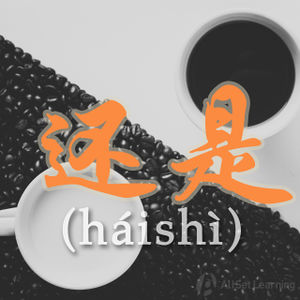Difference between revisions of "Continuation with "hai""
| Line 47: | Line 47: | ||
*父母 不 同意 他 去 ,可是 他 <em>还是</em> 去 了。<span class="pinyin">Fùmǔ bù tóngyì tā qù, kěshì tā <em>háishì</em> qù le.</span><span class="trans">He still went there even though his parents disagreed.</span> | *父母 不 同意 他 去 ,可是 他 <em>还是</em> 去 了。<span class="pinyin">Fùmǔ bù tóngyì tā qù, kěshì tā <em>háishì</em> qù le.</span><span class="trans">He still went there even though his parents disagreed.</span> | ||
*医生 不 让 她 喝酒 ,她 <em>还是</em> 喝 。<span class="pinyin">Yīshēng bù ràng tā hējiǔ, tā <em>háishì</em> hē.</span><span class="trans">The doctor told her to stop drinking alcohol, but she still drinks it.</span> | *医生 不 让 她 喝酒 ,她 <em>还是</em> 喝 。<span class="pinyin">Yīshēng bù ràng tā hējiǔ, tā <em>háishì</em> hē.</span><span class="trans">The doctor told her to stop drinking alcohol, but she still drinks it.</span> | ||
| − | *老师 生病 了,但是 她 <em>还是</em> 来 上课 了。<span class="pinyin">Lǎoshī shēngbìng le, dànshì tā <em>háishì</em> lái shàngkè le.</span><span class="trans"> | + | *老师 生病 了,但是 她 <em>还是</em> 来 上课 了。<span class="pinyin">Lǎoshī shēngbìng le, dànshì tā <em>háishì</em> lái shàngkè le.</span><span class="trans">Even though the teacher is sick, she still made it to the class.</span> |
</div> | </div> | ||
Revision as of 07:38, 14 March 2018
-
Level
-
Similar to
-
Used for
-
Keywords
If you "still" need help on how to use 还 (hái), then this is the page for you.
Contents
Affirmative Form
Usage of 还在
Structure
还在 (hái zài) can be used to indicate that something is continuing - that it's still a particular way.
Subj. + 还在 + [Verb Phrase]
Often the auxiliary verb 在 will appear with 还 (hái) , as it is natural to talk about continuous actions that are still happening.
Examples
- 这 件 事情 我 还在 考虑 。I am still thinking about this matter.
- 已经 中午 了 ,他 还在 睡 ?It's already noon and he's still sleeping?
- 她 还在 生气 吗 ?Is she still mad?
- 你 怎么 还在 用 那个 旧 手机 ?How come you're still using that old cell phone?
- 你 还在 玩 游戏 ?明天 不是 有 考试 吗 ?Why are you still playing video games? Don't you have an exam tomorrow?
Usage of 还是
Here 还是 (háishì) indicates things happened or will happen despite the situation.
Structure
⋯⋯ ,(但是 / 可是 +) Subj. + 还是 + [Verb Phrase]
Examples
- 我 让 他 不要 买 ,他 还是 买 了 。I asked him not to buy it, but he still bought it.
- 他 不 想 离婚 ,但是 最后 还是 离婚 了 。 He didn't want to get divorced, but he still ended up divorcing in the end.
- 父母 不 同意 他 去 ,可是 他 还是 去 了。He still went there even though his parents disagreed.
- 医生 不 让 她 喝酒 ,她 还是 喝 。The doctor told her to stop drinking alcohol, but she still drinks it.
- 老师 生病 了,但是 她 还是 来 上课 了。Even though the teacher is sick, she still made it to the class.
Negative Form
Structure
When you put 不 or 没 after 还 (hái) in a question sentence, it can be used to emphasize the idea of what should be happening in a more idiomatic way.
Subj. + 还 + 不 / 没 + [Verb Phrase]
Examples
- 我们 等 了 半 个 小时 了 ,老师 还 没 到 。We've been waiting for half an hour, but the teacher hasn't arrived.
- 电影 已经 开始 了 ,你 还 没 出门 ?The movie has started already, and you haven't left the house?
- 你 已经 四十 多 了 ,还 不 想 结婚 ?implying the listener should get married nowYou're in your forties, and you still don't want to get married?
- 我 解释 了 这么 多 遍 ,你 还 不 懂 ?I've explained so many times, and you still don't understand?
- 我 对 你 这么 好 ,你 还 不 高兴 ?implying the listener shouldn't be so glumI treat you so well, but you're still not happy?



